What exactly are citron peel and is there a substitute for it? Im in malaysia and im not sure if I can get it here.
A citron is a type of citrus fruit. Here's a link to a
Wikipedia article on citron.
The recipe actually called for mixed peel which isn't avaialbel everywhere. Asking for candied citrus peel at my local markets yielded nothing except from Cosentino's which had candied citron peel in the back (not on display - had to ask for it). If other candied peels are available, you can use those or a mix.
If you can't get candied peels you can make them yourself by cutting up oranges, lemons, and other citrus and simmering it in a simple syrup for half an hour and then letting it soak overnight. Then remove the peel from the remaining fruit and let dry on a wire rack. Alternatively, use golden raisins...
Your conversion in yeast amount is different from what is normally written in the package. Usually 1 envelope weighs 1/4 ounce or 7 grams which equals 2 1/4 teaspoons. And 1 TB equals to 3 tea spoons.
I suspect your density problem had to do with the type of yeast you used and the prep of it. I read through Delilah's recipe and it is I suspect a very important step. as for the crosses, I'd opt out of them too. Are you planning on a re-do?
Love the site!
Ah, but here's the rub - I measured the yeast by using a tablespoon and leveling it - just as Delia specifies. (I didn't use the envelopes for this recipe, instead I scooped instant yeast out and leveled with a straight edge.) I then poured the yeast into a container set on my digital scale where I confirmed it was 12 g. 12 g is the mass of dry yeast according to the USDA Standards and was what I got when I measured my ingredients for this recipe. (I suppose this is an insight into how crazy it is for me to test a recipe... I mass everything and take notes on it - it didn't used to be like this, but somehow this website has taken over my life...)
I just opened up a couple more yeast packets and measured and weighed them. It seems like each packet contains about 2-1/8 teaspoon yeast and it weighs in around 7.75 g (average of five measurements). Because of the error in my scale, I pooled several packets, measured, and divided.
I then measured 4 Tbs. of dry yeast, measured, and divided to yield a value closer to 11 g than to 12 g. So, in my kitchen, using Fleishmann's Active Dry Yeast, 1 Tbs. is 11 g and one packet is almost 8 g (2-1/8 teaspoons).
Two packets of yeast would be a bit much - about 15-16 g instead of 11 g.
Could the amount of yeast be the problem with the recipe? Maybe... in the end I used the method prescribed in the recipe, but did Delia's recipe documenter use the tablespoon scoop and level method or did she use a conversion table?
Will I be doing a redo? Almost undoubtedly. Will it be before this Good Friday? I don't know. I do want to go and watch someone make this recipe and see if I'm over kneading or missing something.
I suspect "the well" has more relevance if you are mixing the ingredients on a board and need to stop the liquid running away (using the dry ingredients to form a wall and then working them in). In a bowl, as you suggest, it is all going to get mixed together pretty soon.
Wulf
The well probably cam from back in the day when teh wet ingredients would have been mixed in a large tub of flour and the ammount of flour used in the recipe determined by how much liquid was added. That is how my grandmother remembered doing all of her baking. Now it is probably a mute point unless you choose to mix in a tub of flour or on a board.
Not sure if this helps, but you should note that British, Australian and New Zealand tablespoons are 20mL or 4 teaspoons, not 15mL or 3 teaspoons like an American table spoon.
Just for completeness, an Australian/British/New Zealand cup is also 250mL not 236mL like an American.
Incidentally, for edible crosses try this:
Combine 75 g plain/cake flour and a 4 teaspoons of white sugar in a small bowl, gradually mix in 1/3 cup water with a teaspoon, and stir untill smooth. You'll get a relatively liquid paste. Either make a homemade baking/greaseproof paper bag and fill it with the paste or fit it to a piping bag with a very small nozzle. Pipe the white lines over the buns just before putting in the oven.
Cheers
Anna
PS your anti-spam code is anna-proof!
There's no need to obsess over how to level the tablespoonful of yeast. Think BIO-engineering here!
For the dense texture, increase rising time and increase the yeast a little, also if you can find it, use fresh yeast, it will result in a better rise.
For the candied citrus peel, use candied orange peel and raisins (or sultanas)
And for the crosses, use a little more water, you want a paste that you can bag onto the bun (cutting strips sucks) and try not to cut such deep crosses into the buns, you really want something more rounded, like using the back of the knife to press crosses into the bun instead of cutting them.
also adding spices to the bun mixture, I use what ever is available and would taste nice in it, cinnamon is good, along with nutmeg.
Perhaps you are determined for this recipe to work...but I have made the one listed in King Arthur Flour's 20th Anniversary Cookbook with great success -- and very authentic except for the strange white paste crosses...
These are made with both white and whole wheat flour, spices, and even a little brown sugar.
If you would like me to post the recipe, I will. Otherwise see the cookbook listed above. (I honestly don't like their cookbook nearly as much as their flour, but this is an exception.)
I really like this article because it didn't all work out. It accurately reflects what many of us face when trying a new recipe. It's a journey into unchartered waters (often times). This article helps to support the fact that we everyone has to get back up on the horse and not be afraid of failure.
I think the "well" was covered earlier. My grandmother (magnificent southern cook) also added the liquid to a general amount of ingredients.
My recipes for Hot-Crossed Buns have the second rise being an hour. The buns will be dense-ish (I like to cut them in half and butter them).
Cheers,
mtc
I have made these buns for many years, using the recipe as originally published in "Delia Smith's Book of Cakes" (1977). The recipe above is close to the original, with two significant differences:
- the original includes a sugar and water glaze;
- and it doesn't have the nasty pastry crosses.
There is also one debatable difference. The original makes rather dense buns, it is true (which I prefer). However, Delia dictates "dried yeast", which is rather different from the "instant yeast" sachets above - this is the old school brown stuff that required activation. This may not make any difference; but it might.
The other differences are minor, like the substitution of citron peel for mixed peel, and giving a mix of spices rather than using "mixed spice".
The original name was "Spicy Hot Cross Buns", which is a fair description. A hot cross bun would usually be a little less tasty than this.
I don't often refer to Delia Online, but when I have, I have noticed a couple of typo errors. I suspect that the missing glaze is the result of sloppy copy editing.
The online recipe does have the glaze, but it's applied after the baking. In the book form, does the glaze come before (to produce a nice brown color) or after the baking?
OK - no, the glaze was applied after baking, and just gives a glossy sheen. Mine are medium brown, not a mahogany colour that it seems you are looking for.
The cooking time with an egg and milk enriched dough should give you a light to mid brown shade. Perhaps an extra 5 minutes?
I stand correcte - according to the Australian Women's Weekly it's Australians ONLY who use 20 mL teaspoons - NZ, UK and the USA all use 15 mL.
In my Australian recipe, the crosses are painted on with a very thin mixture of flour and water. This results in a white cross on a golden bun. After baking the buns are painted with unflavored gelatin dissolved in water which give them a nice sheen.
I thought the well was stupid too, so I tried just dumping in the wet with out the well. Ofcourse all the liquid sloshed to the edges of the bowl and the surface of the flour and made paste. I felt it was enough waste stuck tot he side of the bowl to throw off the flour ratio and also it was a bigger pain to wash the bowl. So now I make the well.
I use a spatula to scrape as I go, but if not doing that I can see why the well helps buffer the liquid from the sides of the bowl...
Making these buns has become a huge contest between my Dad and I, so I would love to add some other things that help. When you shape the buns, put them in a deep dish, and put them close together. This gives you a really soft side to each one. Also the glaze is good if made with the gelatin and water but also add 1/2 tsp of cinnamon - it makes them really brown on top. Having everything really warm makes the yeatst perform better too - use a warm bowl, and keep it warm during the rising process. It is alway cold here at Easter, we use a bowl of hot water under the bowl and the baking tray to keep it all rising well.
I tried Deila's hot cross bun recipe this year for the first time instead of my usual recipe. I was disappointed as they were dense and flat. I used dried yeast that had to be activated. Will go back to old recipe next year.
Boy, these are delicious!
I went on a baking frenzy for the holiday in my new, bigger kitchen here in China (yay!), and my family's traditional Swedish Coffee Bread was the first yeast attempt. I've not had good results with yeast here. The whole wheat bread I baked for Christmas Eve was flat and horridly dense, and last year's coffee bread never rose all the way either. But it came off pretty well this year. After a couple of simpler recipes, I still had time to give hot cross buns a try as well. The envelopes here hold approx. 10-20 grams; I had half an envelope left from the coffee bread, and when I went to buy more, I got a different variety by the same company - well, different designed package, different volume, the only English on both being "Instant Dry Yeast." Anyway, the new envelope had exactly one tablespoon in it, and I tossed in the leftover half-envelope also, which turned out to be another tablespoon, so I probably had twice as much as I was supposed to. Perhaps that's why it rose so beautifully! (Ya think?) ;) Is there any danger if one uses too much yeast in recipes?
I also had to make some substitutions. I bought raisins and an orange, then bothered to look in my cookbook and found that dried cranberries and lemon would be closer... I had some imported cranberries, but had to stick with the orange zest for citron, I wasn't going out again! ([u:99f888f062]The Joy of Cooking[/u:99f888f062] is a great resource, by the way - not exhaustive but almost anything a cook would need.)
I had trouble with the measurements, though. I don't have a scale, so I had to google the conversions, finding recipes that gave both measurements for each ingredient in the amount called for. I ended up with 1/4 cup butter, but after I put it in, I glanced at the package and saw that since it was 125g, I should have put in 2/5, not 1/2, of the stick. *sigh* I ended up putting in another 1/4-1/3 cup flour as I kneaded to keep it from sticking to my hands and get it from cookie-dough to bread-dough consistency. I don't suppose you could put the "supposed" volume measurements on the recipe as well? I understand that they're not as accurate, but a scale is not important enough to merit the expense (and the counter space) for me right now and is probably impractical for many other people. My best guesses on this were:
2/3C water, 1/4C sugar, 1/5C butter, 2C flour, 1tsp salt, 1/4tsp nutmeg, 3/8tsp cinn, 3/8tsp cloves, 1/8tsp ginger (I don't have allspice), 1 egg, 1/3C cran, zest of one orange, and 1(2)T yeast.
I tried brushing them with milk as you mentioned, but they still weren't very brown. Being American, I decided to follow the stereotype and made a milk-and-powdered-sugar paste to fill in the crosses after they cooled, then thinned it with more milk and poured the glaze over the buns. They ended up being mostly eaten for breakfast Easter morning - there was just too much to eat for the birthday party/sleepover the night before - and they were delicious first thing in the morning!
Hi!
do u think i make them with choc pieces instead of currants?!
thanks..
I don't think any European cook could manage without an accurate scale! It's ingrained in our cooking methods. :) Scales can be bought here for less than 5 pounds sterling - so it's not a huge expense.
The reason I try to few US recipes is that the 'cup' method puts me off. What size cup, out of the many in my cupboard, should I use?!
In Cyprus, they often cook by the glass - so long as the glass is the samesized one each time, the ratios are correct - ie one glass sugar to three glasses sugar etc!
I wish the US would go completely metric, but now we are stuck with what we have.
A "cup" is 8 ounces by volume, and is about 236.5 ml. There are 4 cups to a US quart (946ml).
Well, we in the UK used to say that we were 'stuck' with Imperial... look at us now!!!!
BUT, I do have pre-decimalisation scales as well as metric - and have recipes in both measurement systems. I just don't mix them up!
It must drive American engineers mad if they use anything other than metric measurements....!
In my remote South African school days, we were taught that Americans and South Africans tidily measured their teaspoons, tablespoons, cups etc flat whereas the wicked English used rounded measures. Few are more English than Delia, so perhaps that, plus the proofreading glitches, could have been the problem with the dry yeast.
In South Africa we use a 5 ml teaspoon, 15 ml tablespoon and 250 ml measuring cup. To my knowledge, these are US standard measures. We also standardised two pints to be one litre instead of the more accurate 1200 ml, and 2 lb to be a kilogram. The line of least resistance. It works, until you go international - those Oz tablespoons have caused me grief and trauma.
I don't own a scale either - had one once, it broke, and I couldn't be bothered to replace it. So I often have to do sums on the backs of envelopes while cooking. Nothing bad has happened so far.
When Mom was teaching me to cook, she told me that the well method was for the more delicate batters that need to be combined in as few strokes as possible. I can't see that it would be necessary for a kneaded dough, though.
I know that this hasn't been posted to in a while but I figured that I might have some luck explaining a few things.
I have been a cook for quite some time (about a decade or so) and I have dabbled in baking. This does not mean that I am too qualified to give advice though...
Baking is to cooking as Geometry is to art. It requires far more precision than experimentation.
As for what could have been the error, there are multiple possibilities.
Some are as follows:
The more you kneed dough the more gluten you create causing increased density. If you over-kneeded the dough to fully incorporate the ingredients then you could certainly have caused density issues.
Your location. Or rather your air moisture as well as your height above sea level can change recipies a great deal. Including but not limited to an increase in liquids or flour by up to a 1/4 cup (2 oz). If you added flour until dough was no longer sticky then this could change the recipe quite a lot.
There are other possible reasons but this is enough for now.
As for "The Well"
There is a very good reason that it is used. When you have the liquid ingredients inside the center of "the well" you are supposed to mix the wet ingredients as to slowly incorporate the dry via the friction of the moving liquids. You are NOT supposed to mix much of the dry ingredients, the wet should pull enough dry in at one time. This will lower the amount of gluten created by overmixing even if it takes a longer amount of time to mix and reduce the amount of "Flour pockets" that can be created by careless mixing.
Strangly enough "the Well" method is also used in Pasta creation which relies heavily on the production of gluten to make the strong bonds of the pasta. The well is used in this instance is the reason stated by others previously, which is that it reduces spillage of wet ingredience while mixing on a cutting board or other flat surface.
I hope this wasn't too much of a novel and I again incourage you to take my advice with a grain of salt as since I am not an actual professional baker (Athough I do bake quite often.)
Ghancock
The success of your baking depends on many factors.
First, are you using yeast or some other rising factor? If you are using baking powder or baking soda, you will want to use a low-gluten flour like cake flour, or flour that has a small amount of gluten in it, like all purpose flour. You also want to be careful not to over-mix the batter, because that will make it tough. Cakes, scones, and sweet breads are usually made this way. You also will want to measure carefully. This kind of baking is affected by altitude, water hardness, the amount of moisture in the air and in your flour, and many other factors.
If you are using yeast, it is better to use a higher gluten flour and to knead it for at least five minutes in order to encourage the protein strands that will trap the gasses produced by the yeast. This is the method used for pizza dough and most plain breads.
The addition of milk, butter, sugar or potato water will tenderize your final product. Two or three long, slow risings with very little yeast will give you more "bread" flavor. Salt slows down the action of yeast. Sugar speeds it up.
My experience (in other words, my many failures) teaches me that tough, dense bread means that I added too much flour or did not let the dough rise long enough. Baking bread takes experience, and when you are familiar with how the dough should look and feel at each stage, you don't even need to measure. I have found that a good bread book with an explanation of the processes and how various ingredients affect the final product is a great start. There is a lot of mystery connected to bread baking, but in a way it is simpler than almost any other cooking.
Practice, patience, and good luck! :)
Of my experience in pasta making with my family, the well is used for a couple of reasons:
1) poor people in southern Italy didn't have mixing bowls
2) it allows you to use just the right amount of flour
The flour will pull moisture from the air on humid days, and not so much on dry ones. You start with more flour on the board than you think you need, make a well, add the wet ingredients (usually water and egg), and combine. If all the flour isn't taken up, you either leave the remnants (using later for rolling) or add more water.
The BEST recipe for these Lenten treats come from Stella Standard's classic "Our Daily Bread". Light, nicely spiced and crossed with a powdered sugar frosting that includes lemon zest. Yummm!
My dad always baked his buns very close together in a tray with sides so they touched and filled the whole tray after they had risen before baking.
Having lived in England, Canada and the USA, there is a significant difference in the "hardness" of flour in the three countries (and some difference even between the millers). Flour is much harder in North America than England and Canada's being slightly harder than American ... presumably this is in part due to climate. Cake and pastry flour is fairly consistent.
Hardness impacts the bread consistency.
Canada produces high proportions of durum wheat which is a very hard wheat and used for breads and pasta.
Next is common wheat or bread wheat ... with various substrains which are commonly used for all-purpose or plain flour. (English "self-raising" flour is rarely seen in N. America) The softer strains are used for cake flour.
So, just as we see differences in breads (N. American "French" or "Italian" bread is only marginally similar to their namesakes and often give the impression of the loss of texture of frozen "prebake" breads presumably because of the attempt at a softer bread by using all-purpose flour blends), we can expect to see differences in the texture of things like hot cross buns
To get better texture, try flour blending :)
Here's my aussie recipe - took me 6 recipes and as many batches to perfect something that didn't resemble a cricket ball. the flavor is superior and the texture is as per those you get downunder. enjoy!
Aussie Hot Cross Buns
245 Minutes to Prepare and Cook
Ingredients
**Buns
packet yeast 2.25 tsp
butter, 4 tbsp
Milk, nonfat, 1.3 cup
Brown Sugar.25 cup
Vanilla Extract, 1 tsp
Cloves, ground, .25 tsp
Cinnamon, ground, 2 tsp
Pumpkin Pie spice, 2 tsp
Orange zest, organic, 1tsp
1 Egg
Wheat flour, white, all-purpose, enriched, 4 cup
Salt, 1 tsp
Currants, Sunmaid Zante, 0.3 cup
**Crosses
Granulated Sugar, 1Tbsp
Wheat flour, white, all-purpose, .25 cup
water (to make thick paste ratio 5:3 flour to water)
**Glaze
Granulated Sugar, 1Tbsp
Gelatine, 1 packet ~1 teaspoon
Boiling Water, 1Tbsp
Directions
Place Buns ingredients in bread machine in the order listed, Kneed for 6 minutes only adding currants at the 4 minute mark. Allow to prove for 45mins to an hour till doubled in size.
weigh dough and divide into 12ths. gently kneed into rolls and place on baking tray. Allow to prove for another hour till rolls have doubled in size.
mix paste ingredients together so no lumps exist, pipe crosses on rolls. A plastic bag with the corner snipped off makes a great makeshift piping bag.
Bake in 350 degree oven for 25-30 minutes till rolls are 190 degrees in center.
Mix gelatin sugar and water and heat in microwave or on stove for 1-2 minutes till sugar is dissolved and glaze reaches about 200 degrees. Use pastry brush to brush glaze over tops of hot rolls. Serve while still warm or allow to cool and server toasted with butter.
I am a baker, so here's my two cents...
One of the things mentioned in Delia's recipe on Delia Online is that "... easy-blend dried yeast is not suitable for this recipe." I assume from what she's saying, she didn't use INSTANT yeast she just used DRIED yeast as in the ingredient list. There is a big difference. Instant yeast can be mixed in with the flour and dry yeast needs much longer to activate, this is why in the beginning of her instructions she activates the yeast in warm water and sugar until it is frothy.
Also, you can't rely on someone else's timing for proofing dough unless they're baking in the same room as you are. England is much more humid than many parts of N.A. If you stick your fingers in the dough and the indents do not bounce back, then it's ready. I think it needed more time in your first rise.
You might want to look into the technique used for rolling buns. More surface tension would have given a smoother texture and also a better rise.
I believe the more traditional cross is a paste of flour and water, but it would be much thinner than what Delia used and would be piped on. Moving the tray closer to the top of the oven for the last 5-10 minutes would increase the browning.
I've made this recipe a few times and I found that the buns were softer if left to prove for longer than recommended (it's also the end of summer about easter time in the southern hemisphere so it's warmer). I put the crosses on before they go in the oven. I also make them wetter and thinner, i've even piped the on once. I've also made this using choc chips (used cocoa in the crosses) and also with glace cherries and both are nice.
I used the very same recipe on the very same day and got the very same results. Since I'm used to eating hot cross buns since childhood I binned the first batch and a) doubled the yeast, and b) made a thinner paste that I piped on for the second batch, which came out perfect. The buns should be brioche-like in taste and feel.
Does Delia use a 15ml American tablespoon or a metric 20 ml one?
..... into 2 tablespoons (30 mL) hot water to form....
should work.
Delia uses metric tsp.
msg #1 explicitly cites:
..... into 2 tablespoons (30 mL) hot water to form....
there may be new math,
there may be old math,
but 30 ml is still 30 ml.
mine came out that way too, but when my mum makes them they are always huge and puffy. I can only assume I didn't knead the dough for long enough.
you should change the recipe a little to look like this:
(all % are calculated in relation to the amount of flour you use!)
100% flour (Type 550 - or all purpose)
20% Butter
10% Sugar
5% Yeast
1,5-2% Salt
40% Milk
~2 egg yokes per kilo
+ now throw in all the stuff you want in it, choclate chips, dried aplles (soak in water first!), sultanas (soak in water first as well!)
up to ~15% of ingrdients are ok.
First take the flour, salt, sugar, butter, yeast, yokes and milk and make a dough. this may take a while because the gliadin and glutenin protein parts of the flour need some time to combine and hold the dough.
The dough is ready when the dough does no longer stick to your fingers easily and can be strecht whithout falling apart (it should be really strechy!) now cut it a little into pieces and put your ingredients on it, start molding all togerther until it is one fine ball of dough.
When you´re done take some plastic foil and place it over the dough and let it rest.
preheat oven to 220°C dunno what that is in °F. Put a soup plate full of water in the oven as well, you want to get some steam in there!
Let the dough rest for 10-15minutes then take away the plastic foil and hit (yeah hit) the dough and press it down a little, that way you destroy the tiny gas bubbles made by the yeast in the dough, so instead of one big bubble you have smaller bubbles in the dough.
Wait another 5-10 Minutes then take away the foil and portionize it into 65-70g pieces and mold them a round or long or whatever.
When done put them somewhere warm and cover them so the "skin" does not dry out.
when they reach about 3/4 of their maximum size (almost twice the size they used to be) put them on your baking paper/grill/whatever you use and put them in the oven, after about 10 minutes take out the soup plate (we dont need no more steam now) and close the oven again and turn it doen to round about 180°C.
give them another 6-8 Minutes (inside they should reach 94°C! if they dont and you think they are getting to dark, cover them with baking paper and put them on a lower level in the oven.
When the get out of the oven, use a little brush and cover them in water (JUST A LITTLE - dont bath them!) let them cool down.
- perfect sweet buns -
I really want to make this for a class but I don't have enough time to use the yeast. Is there a way to make this but without yeast or self rising flour (If you were going to suggest it)
 I started by gathering all my supplies according to the recipe: 50 mL warmed milk and 150 mL warmed water, 50 g sugar, 50 g melted butter, 450 g all-purpose flour, 1 teaspoon table salt, 1/4 teaspoon ground cinnamon, 1/4 teaspoon ground nutmeg, 1/4 teaspoon ground allspice, 1/4 teaspoon ground cloves, 1 large egg (beaten), 75 g dried currants, 50 g candied citron peel, and 1 tablespoon instant yeast (about two envelopes).
I started by gathering all my supplies according to the recipe: 50 mL warmed milk and 150 mL warmed water, 50 g sugar, 50 g melted butter, 450 g all-purpose flour, 1 teaspoon table salt, 1/4 teaspoon ground cinnamon, 1/4 teaspoon ground nutmeg, 1/4 teaspoon ground allspice, 1/4 teaspoon ground cloves, 1 large egg (beaten), 75 g dried currants, 50 g candied citron peel, and 1 tablespoon instant yeast (about two envelopes).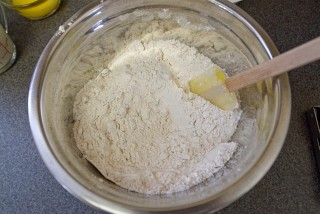 I mixed the dry ingredients together (flour, sugar, salt, spices, currants, peel, and instant yeast) until everything was evenly distributed.
I mixed the dry ingredients together (flour, sugar, salt, spices, currants, peel, and instant yeast) until everything was evenly distributed.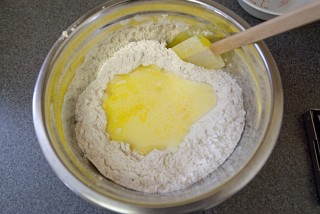 As per Delia's instructions, I made a well in the dry ingredients and poured in all the wet. (I've often been suspicious of the "well" - as soon as you start to mix, everything gets wet, so why bother with the well?)
As per Delia's instructions, I made a well in the dry ingredients and poured in all the wet. (I've often been suspicious of the "well" - as soon as you start to mix, everything gets wet, so why bother with the well?)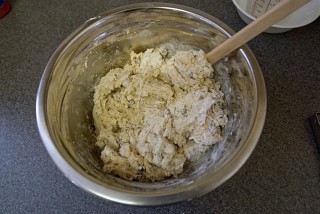 I mixed it into a dough with a wooden spoon.
I mixed it into a dough with a wooden spoon.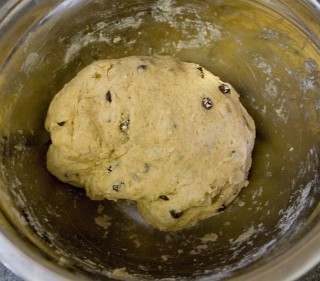 Then I kneaded it with my hands until smooth and elastic. I put it back into a large bowl and covered with plastic to rise.
Then I kneaded it with my hands until smooth and elastic. I put it back into a large bowl and covered with plastic to rise.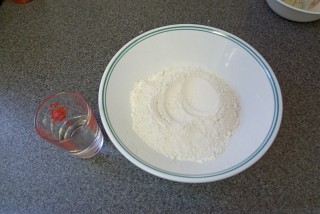 While the dough was rising I fashioned the (optional) material for the cross. Delia's website simply says, "If you want to make more distinctive crosses, use a flour-and-water paste made with 4 oz (110 g) plain flour and approximately 3 tablespoons water. Roll out thinly and divide into small strips, dampening them to seal." So, I measured out 110 g all-purpose flour and 3 Tbs. water.
While the dough was rising I fashioned the (optional) material for the cross. Delia's website simply says, "If you want to make more distinctive crosses, use a flour-and-water paste made with 4 oz (110 g) plain flour and approximately 3 tablespoons water. Roll out thinly and divide into small strips, dampening them to seal." So, I measured out 110 g all-purpose flour and 3 Tbs. water.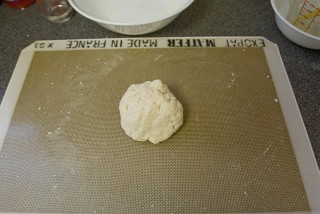 I mixed the flour and water together and worked it until the water was evenly distributed and dough that I could roll out was formed.
I mixed the flour and water together and worked it until the water was evenly distributed and dough that I could roll out was formed.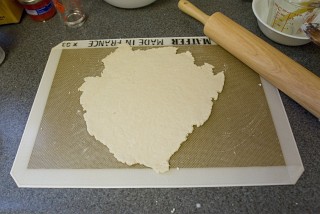 I rolled out the dough to a 1/8-in. thickness.
I rolled out the dough to a 1/8-in. thickness.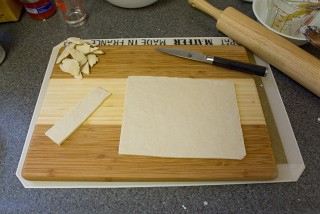 I trimmed off the edges to form a rectangle of dough.
I trimmed off the edges to form a rectangle of dough.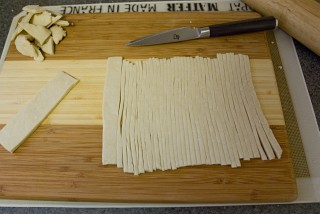 Using a sharp knife, I cut the dough into thin strips. These strips will be used in pairs to form a cross on top of the bun. In the United States, a milk and sugar frosting is often used instead - but I wanted to stick with a more British recipe. I covered the strips with a piece of plastic wrap to keep them from drying out.
Using a sharp knife, I cut the dough into thin strips. These strips will be used in pairs to form a cross on top of the bun. In the United States, a milk and sugar frosting is often used instead - but I wanted to stick with a more British recipe. I covered the strips with a piece of plastic wrap to keep them from drying out. After an hour, the dough for the hot cross buns had doubled in volume - a good sign.
After an hour, the dough for the hot cross buns had doubled in volume - a good sign.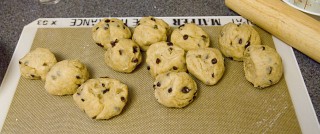 I kneaded the dough to deflate it and then cut it into twelve pieces.
I kneaded the dough to deflate it and then cut it into twelve pieces.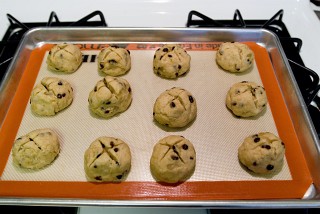 I the rolled the pieces into balls and evenly spaced them on a half sheet pan. I cut crosses into the top of each bun and covered them with plastic wrap to allow them to rise again.
I the rolled the pieces into balls and evenly spaced them on a half sheet pan. I cut crosses into the top of each bun and covered them with plastic wrap to allow them to rise again.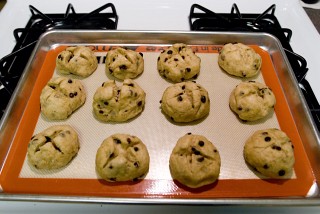 I started preheating the oven to 425°F (220°C). After about thirty minutes, they had risen again.
I started preheating the oven to 425°F (220°C). After about thirty minutes, they had risen again. I then laid the strips over the deep furrows in the buns and trimmed the ends with shears.
I then laid the strips over the deep furrows in the buns and trimmed the ends with shears.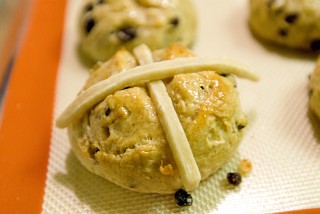 Fifteen minutes later, I pulled them out of the oven and got this.
Fifteen minutes later, I pulled them out of the oven and got this.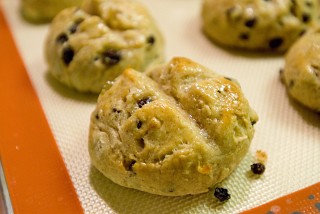 The crosses were as hard as twigs and the color of the buns was, as I expected, not at all similar to the picture on the website.
The crosses were as hard as twigs and the color of the buns was, as I expected, not at all similar to the picture on the website.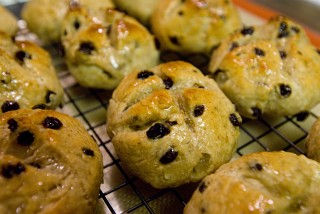 I decided to pull off the crosses (they are optional after all) so Tina wouldn't break a tooth while tasting the buns. I then dissolved 2 tablespoons (25 g) sugar into 2 tablespoons (30 mL) hot water to form a sticky, simple syrup glaze.
I decided to pull off the crosses (they are optional after all) so Tina wouldn't break a tooth while tasting the buns. I then dissolved 2 tablespoons (25 g) sugar into 2 tablespoons (30 mL) hot water to form a sticky, simple syrup glaze.